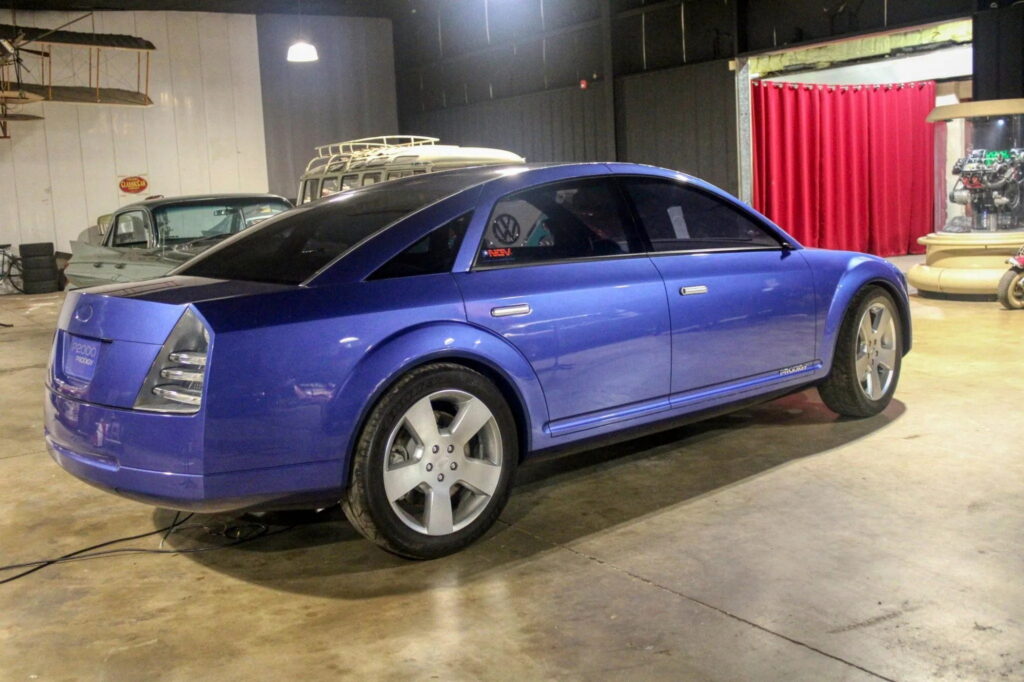The rolling model is for static display only, as it lacks the original concept’s 72 mpg 1.2-liter diesel-hybrid powertrain
1 hour ago
 –>
–> 
–>
- A static display prototype of the Ford Prodigy concept that debuted at the 2000 NAIAS in Detroit, is being offered for sale.
- The original concept was envisioned with an aluminum body, a diesel-hybrid powertrain, and a drag coefficient of 0.199 cd, resulting in a remarkable fuel consumption of 72 mpg.
- The pictured vehicle lacks a drivetrain, featuring a composite shell built upon a supporting structure made of wood and steel.
Calling all 2000s concept car enthusiasts – now’s your chance to own a piece of automotive history: a 2000 Ford Prodigy. However, a heads-up – this is not the actual concept, but a full-scale display model of that car which Ford built for promotional use following the introduction of the concept study.
The rolling model is strictly for static display purposes only and lacks the concept’s 72mpg diesel-electric hybrid powertrain and any functional components. But hey, it’s offered at no reserve, making it an potentially attractive acquisition for a private museum or dedicated Ford fan cave.
The Ford Prodigy Concept made its debut on the cusp of the new millennium at the 2000 North American International Auto Show (NAIAS) in Detroit. Alongside the GM Precept and the Chrysler Intrepid ESX3 concepts from the same year, it was part of a government-backed research program that encouraged the Big Three to develop efficient and lightweight automobiles.
More: Ford GT90 Concept Found In Tiny Oklahoma Town
Unfortunately, none of the resulting concepts reached production by 2003 as intended. However, Ford’s static prototype was preserved, rather than meeting the fate of most old concepts and prototypes, which usually end up in the crusher. Not only that, but its design went on to influence the exterior of the 2005 Ford Five Hundred and even inspired the horizontal “three-bar” grille that debuted on the 2006 Ford Fusion.
A 72 MPG Diesel-Electric Hybrid Powertrain
The 2000 Ford Prodigy Concept – not to be confused with the rolling prototype for auction (photos Ford).
While the prototype being sold lacks a functional powertrain, the Prodigy Concept was initially conceived with a diesel-hybrid system. This setup included a 73hp 1.2-liter diesel engine and a 46 hp single electric motor, producing a combined output of 120 horsepower. Though modest in power, the estimated fuel consumption rating of 72 mpg (3.3 lt/100km) came very close the program’s target of 80 mpg (2.9 lt/100km), highlighting the potential of hybrid technology for achieving fuel efficiency.
Beyond the powertrain, the remarkable efficiency of the Ford Prodigy was made possible thanks to its lightweight aluminum body, tipping the scales at a featherweight 2,387 pounds (1,083 kg). Additionally, it boasted exceptional aerodynamics.
Don’t be fooled by its resemblance to a rolling Lego brick as the Prodigy boasts a drag coefficient of 0.199 Cd, outperforming the 0.20 Cd figure of the Mercedes-Benz EQS, currently the most aerodynamic production vehicle on sale.
Familiar Design Traits

The Prodigy’s silhouette bears an uncanny resemblance to Audi concepts of the era. This connection isn’t purely coincidental. J Mays, who served as the global Vice President of Design for all eight Ford Motor Company brands at the time, previously held a design position at the Volkswagen Group. There, he was responsible for cars like the influential Audi Avus Quattro Concept, which paved the way for the first-generation Audi TT.
A closer look at the Prodigy concept reveals its lasting influence on future Fords. Beyond the inspiration for the 2005 Ford Five Hundred, the Prodigy’s design fingerprints are evident in other production vehicles. The vertically stacked headlights foreshadowed the look of the first-generation Ford Fusion, while the pronounced fenders hint at the design language used on the third-generation Mondeo.
Even the 19-inch wheels with Goodyear tires were ahead of their time, giving the Prodigy a bit of a crossover-like stance that wouldn’t become mainstream for several years.
More: We Spotted The Ares S1 Concept Based On A C8 Corvette At A Dealership
Instead of the NAIAS concept’s aluminum body and chassis, the rolling prototype seen here features a composite shell over a support structure made of wood and steel. The doors and plastic windows do not open, preventing access to the partial mockup of the interior. However, the taillights illuminate when connected to a 120-volt power supply.
The Ford prototype can be purchased from an online auction by Bring A Trailer, where it’s offered without reserve and with no estimates for its value. The current owner is a Florida-based dealer who acquired it in 2018 at an undisclosed price. The last time we heard of the Ford Prodigy was back in 2010 when it was auctioned for charity, fetching $15,400 at the RM Auctions Sports and Classics of Monterey.

